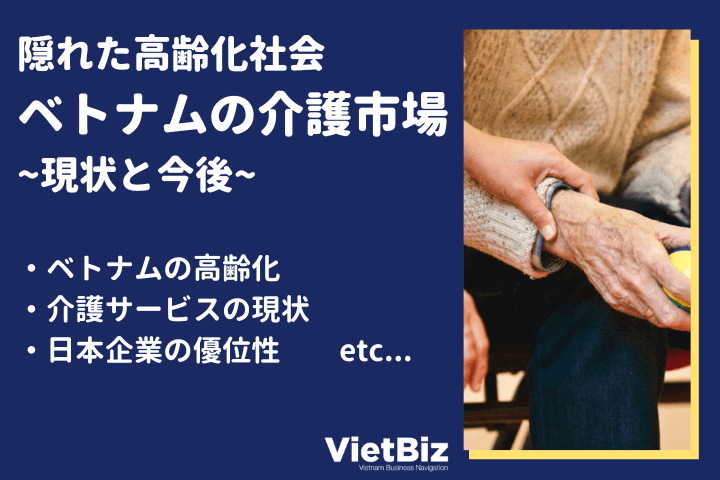Introduction
Vietnam is experiencing an aging population, and the market potential for medical services for the elderly, such as long-term care, has been recognized as very high. However, not many companies are interested in investing in this field: as of 2022, Vietnam still has very few human resources in both the public and private sectors to care for the elderly, relying mainly on family members. There is also a great shortage of nursing personnel and physicians specializing in geriatrics, and not enough knowledge and expertise in geriatrics.
This report focuses on the potential needs and market prospects for long-term care services in Vietnam and concentrates on the development potential of the long-term care services market.

Why Is The Vietnamese Nursing Care Market Attracting Attention?
Vietnam has officially entered the “aging phase” since 2011, with the elderly population accounting for 11.86% of the total population in 2019; the percentage of elderly is projected to increase to 16.53% by 2029 and 24.88% by 2049. Vietnam has one of the fastest aging populations in the world. Whereas it took developed countries decades to reach the same level of aging, such as France (115 years) and Australia (73 years), Vietnam is projected to reach the same level in only 23 years.
The plan based on Decision 403/QĐ-BYT issued by the Vietnamese government clearly defines the Vietnamese government’s view on aging. Increasing life expectancy is one of the key outcomes of socioeconomic development in general and health care in particular.” However, the rapid aging of Vietnam’s population poses significant challenges to the social assistance system, labor force and employment, transportation, and entertainment and recreation, especially the health care system for the elderly.”
From a business perspective, these challenges and issues of an aging population, against the backdrop of Vietnam’s rising incomes and economic growth, represent a significant business opportunity for the development of services for the elderly, including long-term care. On the other hand, the supply of long-term care services in Vietnam is highly fragmented, scattered, and significantly underdeveloped compared to the diverse and rapidly growing demand. It is also reportedly under significant pressure, particularly due to the new corona epidemic.
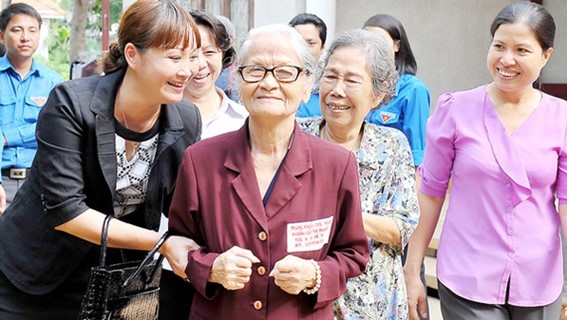
In Vietnam, The Population Is Aging, Especially in Urban Areas.
In 2019, it was 64.85% of the total population, down from 66.86% in 2009. Although Vietnam remains in the golden age of its population, the country is gradually aging, making it one of the fastest aging countries in the world.
The increase in life expectancy in Vietnam can be attributed to the fact that more people have access to medical services and the quality of medical services is improving. Statistical data over the past 30 years show that mortality rates have declined and life expectancy has increased. Between 1989 and 2019, life expectancy in Vietnam increased from 62 to 71 years for men and from 67 to 76.3 years for women.
The figure below shows the rate of increase in life expectancy for men and women in Vietnam. In the future, Vietnamese people are expected to live longer, with life expectancy for men and women projected to reach 72.7 and 78.7 years, respectively, by 2034.
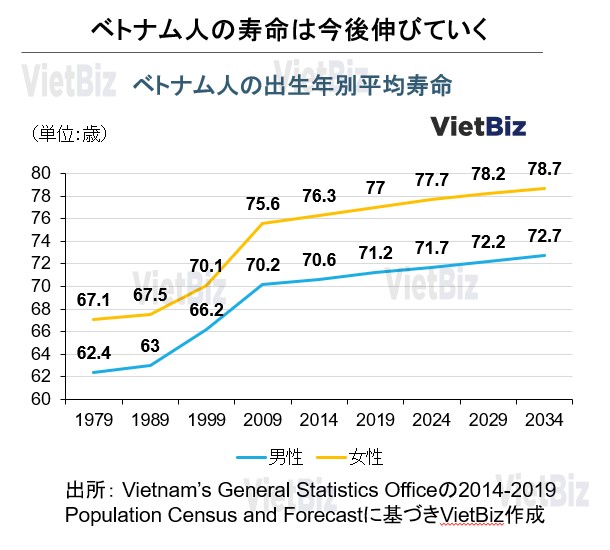
In 2020, the percentage of Vietnam’s population aged 65 and over reached about 7.9% (about 7.7 million people). Thus, one out of every eight people is aged 65 or older; by 2050, the percentage of Vietnam’s population aged 65 or older is projected to reach 20.4%.
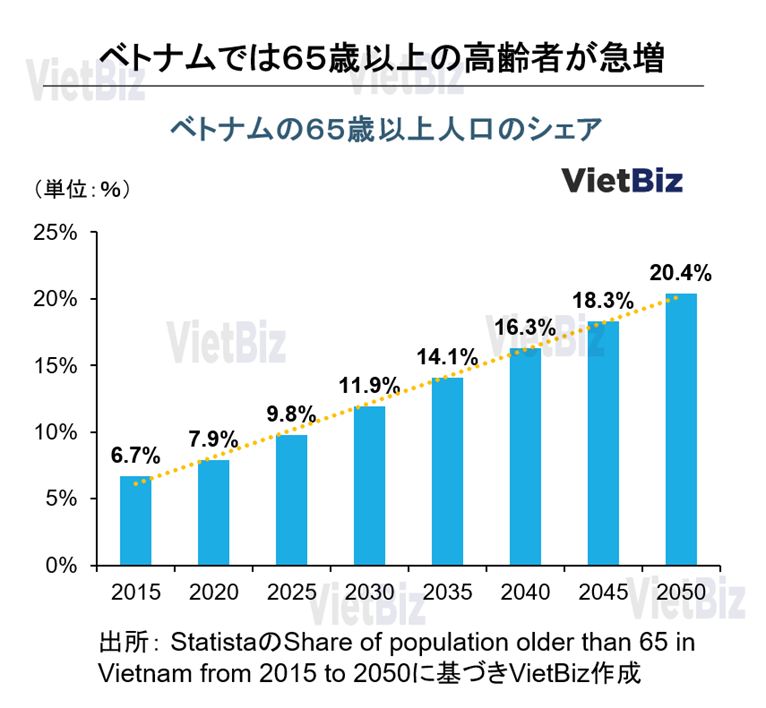
Compared to other ASEAN countries, Vietnam has ranked third in the ratio of elderly since 2000, after Singapore and Thailand, and is projected to be the third country in ASEAN in 2040 as well.
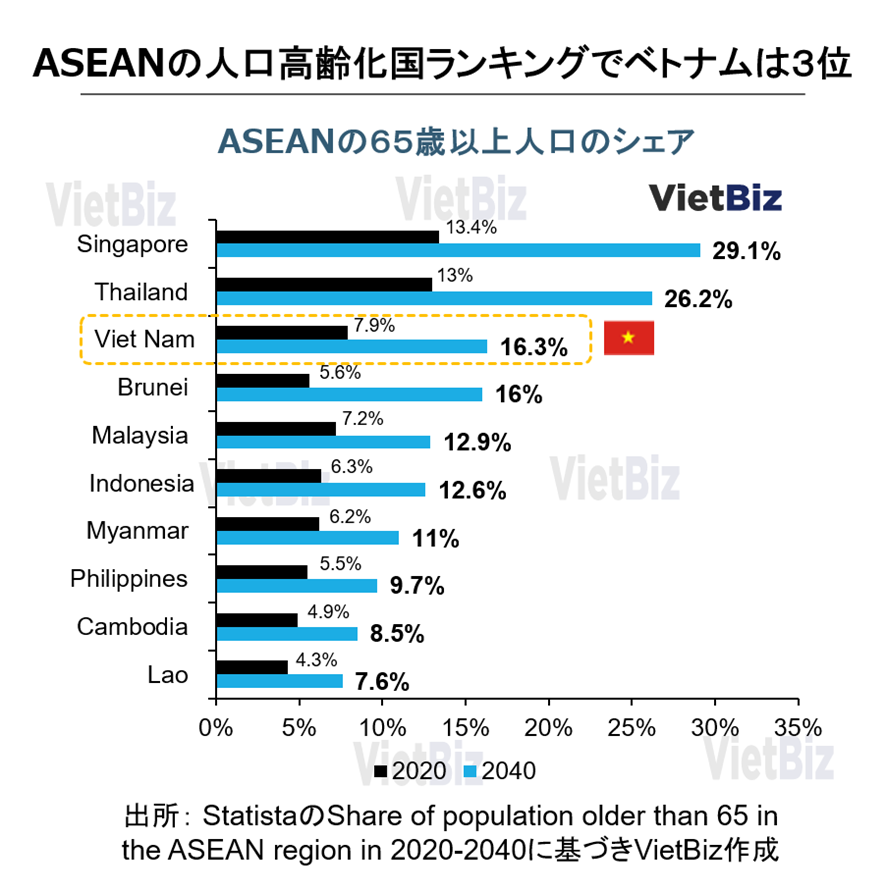
Vietnam also has the highest percentage of female elderly among ASEAN countries, according to a 2019 report by the United Nations Population Fund (UNFPA).
Most of Vietnam’s elderly live in rural areas. In the future, however, the proportion of elderly living in rural areas is expected to decrease, while the proportion of elderly living in urban areas will increase.
The figure below shows the projected distribution of the elderly population by rural and urban areas from 2029 to 2069; by 2069, the proportion of elderly living in urban areas is expected to be twice that of those living in rural areas.
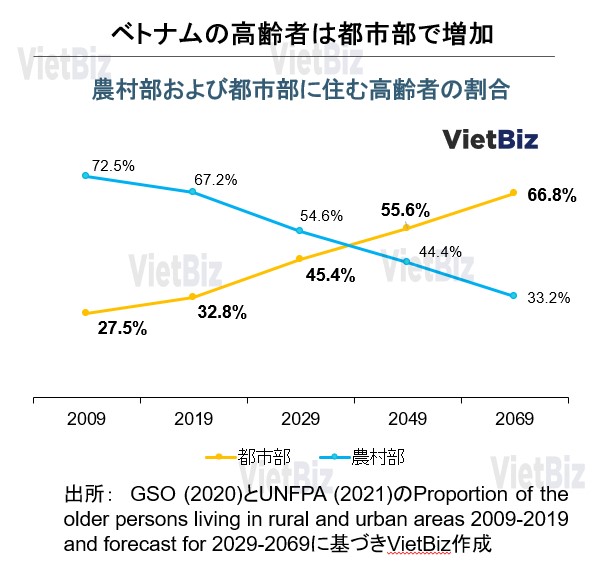
Furthermore, the North Central Coast and the Northern Delta are the two most densely populated regions in the country. Correspondingly, these two regions have the highest proportion of elderly people among Vietnam’s six regional divisions, the Mekong River Delta region is third, and the Central Highlands has the lowest.
The Market Size Is Expanding.
Vietnam’s long-term care market is estimated to grow at an annual rate of up to 7% between 2020 and 2027, according to a report by the Vietnam Chamber of Commerce and Industry (VCCI). The Asia-Pacific region is a market of great value, with an increase of 7.7% to 14.6% from 2018 to 2022, according to the report.
Vietnam is also a promising market for long-term care services, with an estimated 20 million potential customers by 2035. Specifically, customers fall into three categories.
Elderly People Who Have Difficulty with Activities of Daily Living
The proportion of elderly people with at least one difficulty with activities of daily living is 37.6% (Vietnam Women’s Union, 2012). 4 million elderly people had at least one difficulty with activities of daily living in 2015, and this number is estimated to increase rapidly to It is estimated that this number will increase rapidly to approximately 5 million by 2025 and 8 million by 2039.
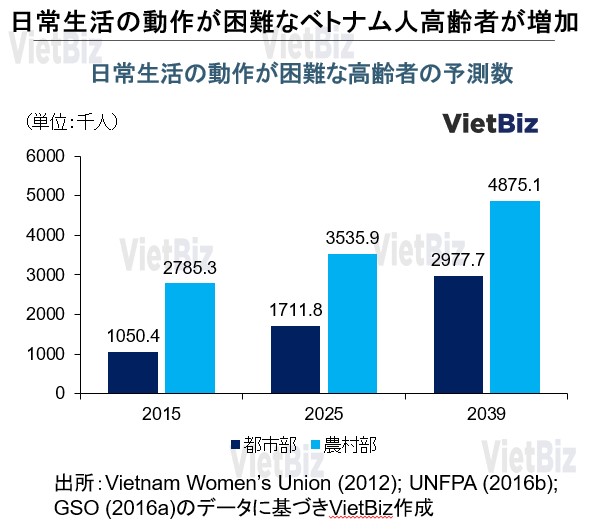
Elderly People with Mobility Difficulties
The proportion of elderly people in Vietnam with mobility difficulties is 71.6%; in 2015, there were 7.4 million elderly people in need of care; by 2025, it is estimated that there will be approximately 10 million elderly people in need of care, and by 2039, the number will exceed 15 million.

Elderly with emory loss
In Vietnam, 48% of the elderly have memory loss (Vietnam Women’s Union, 2012); nearly 5 million people will need long-term care in 2015, and that number is estimated to grow to nearly 7 million by 2025 and approximately 10 million by 2039 It is estimated that this number will increase to nearly 7 million by 2025 and approximately 10 million by 2039.
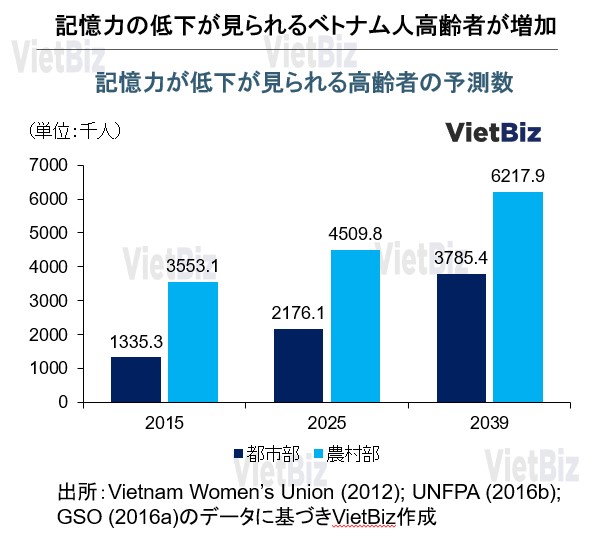
In 2011, many older adults needed care, but only 36% of them received assistance even though they had difficulties with activities of daily living (Vietnam Women’s Union, 2012). It is estimated that the percentage of elderly who have difficulties with activities of daily living but do not receive assistance will remain high (73%). Long-term care systems need to be developed.
Vietnamese Practices of Caregiving Are Changing.
Vietnam’s long-term care services market has great potential. On the other hand, it will face the challenges of stable provision of long-term care services and increasing cost burdens.
First, the increase in life expectancy has increased the need for health care and social care among the elderly over 60 and 80 years old. Besides, if the birth rate declines in the future, over time the need for care by relatives (children and grandchildren) of the elderly will decrease. Many elderly are beginning to choose to live alone.
Several studies indicate that older Vietnamese are more likely to live independently, including moving to nursing homes. There is an increasing need to provide care (non-family or third party) for the elderly.
The long-term care services market has great potential, especially for potential clients who are concerned about their physical and mental health. A survey on independent living among Vietnamese singles aged 30-45 (Prudential 2020) found that the top concern for respondents was physical health (59%), followed by mental health (30%), and finally finance. An estimated 85% of respondents want to live independently in old age. This percentage is even higher for the group most concerned about the financial problems of the elderly (95%), which is expected to be difficult, especially considering that only 40% of respondents have planned for retirement by age 45.
In the next 15 to 20 years, these people will become potential clients of elder care services. As per the survey, only 4 out of 10 Vietnamese are planning for retirement. However, according to the 2019 Survey of the Elderly (VNAS 2019), less than 25% of the elderly have savings.
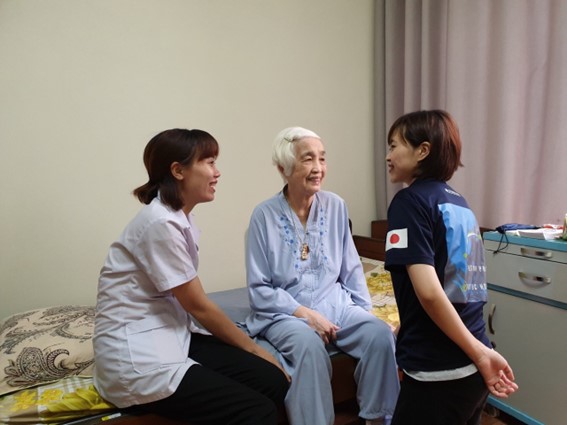
While more and more people wish to live an independent retirement, building a safety net to prevent lonely deaths is also an issue for Vietnam in the future.
In terms of the future needs of Vietnam’s long-term care market, healthcare services will be the first priority for the growing elderly population, followed by independent living (community care) and spiritual fulfillment services.
Legal Provisions for Long-Term Care Services in Vietnam
Although Vietnam has policies that are basically prerequisites, there are still many reforms that need to be continued, especially specific strategies and plans to make long-term care for the elderly a reality for society as a whole.
Vietnam Ministry of Health: Decision No. 403/QD-BYT
The purpose of this decision is to issue an action plan to implement the Ministry of Health’s Health Care Program for the Elderly until 2030, in order to implement Prime Minister’s Decision 1579/QĐ-TTg dated October 13, 2020, which approved the Health Care Program for the Elderly until 2030.
The decision established a framework for the development of long-term care services through public-private partnerships as a key pillar of
- Development of a medical model for the elderly:
- Investments to strengthen the capacity of hospitals (except pediatric hospitals), technical assistance to medical staff for consultation, rehabilitation, and primary care.
- Hospitals (excluding children’s hospitals) at the national, provincial, and district levels to develop standards for geriatric outpatient, geriatric, and general hospital beds dedicated to the elderly.
- Communes and ward clinics to carry out primary care tasks and prevent non-communicable diseases of the elderly at home and in the community. Main tasks include building knowledge about building the body, improving health, building knowledge for the prevention of chronic diseases and other common diseases of the elderly, and providing primary care and rehabilitation support in the community.
- Model development of day care centers.
- Development of models for senior health care clubs; incorporation of senior care into intergenerational clubs and other senior clubs. Training and support of community volunteers to monitor and assist local seniors with chronic and non-communicable diseases in their homes.
- Development and piloting of models of senior-friendly communes.
- Development/piloting of appropriate models of nursing homes/centers, socialization of models and participation in private investments.
- Development/piloting of IT applications in health care services for the elderly.
- Regular training and re-training of medical staff and caregivers at all levels, as well as community peers and volunteers.

Decree No. 20/2021/ND-CP
The decree not only raises the level of support for the elderly, but also expands and organizes the support areas into five groups, giving them the right to receive benefits.
- Elderly members of poor households with no caregiver or with a caregiver who receives a monthly social allowance.
- Elderly persons between the ages of 75 and 80 from poor households or from households above the poverty line living in ethnic minorities or mountainous areas.
- Elderly persons over the exact age of 80 who do not have a pension, monthly social allowance.
- Elderly persons from poor households who do not have a caregiver and do not qualify for admission to a social assistance facility, but who have a caregiver.
Law No. 39/2009/QH12 on the Elderly
Vietnam’s Law on the Elderly stipulates that
- Article 14: The government shall encourage private investment in cultural, educational, physical education, sports, recreational and tourist facilities: d) encourage businesses and individuals to produce and trade products and goods tailored to the needs of the elderly.
- Article 15: New construction and renovation of housing complexes, public utilities, and public transportation must be appropriate to the characteristics and usage of the elderly.
- Article 20: The Government encourages the private sector to invest in the following three forms of care facilities
- Social protection facilities.
- Elderly counseling and service facilities.
- Other forms of long-term care facilities.
In addition, organizations and individuals who contribute and invest in the construction of nursing homes with their own funds may receive preferential policies in accordance with the Law on Socialization Promotion Policies for Activities in the Education, Vocational Training, Health, Culture, Sports, and Environment sectors.
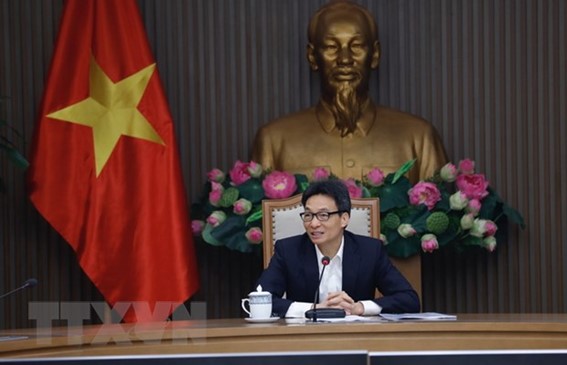
Major Types of Care Services in Vietnam
In Vietnam, care is provided by family members who are not particularly qualified or supported by outsiders. Care provided by family members is increasingly reduced and inadequate. Some people with complex care needs require more support than their families can provide.
Although many people have access to long-term care, there are no formal standards regulating long-term care services. Thus, there is variation in the quality and methods of care among regions.
Intergenerational self-care involves a multisectoral approach to community development that includes health promotion and prevention activities and promotes volunteer-based home care. Paid home care has been touted as a means to assist older adults who do not have the means to pay for private care (Ministry of Health and Welfare, 2016). Residential care is important for the very small number of people who are unable to provide safe and adequate care in their own homes.
The table below summarizes the major models of care in Vietnam.
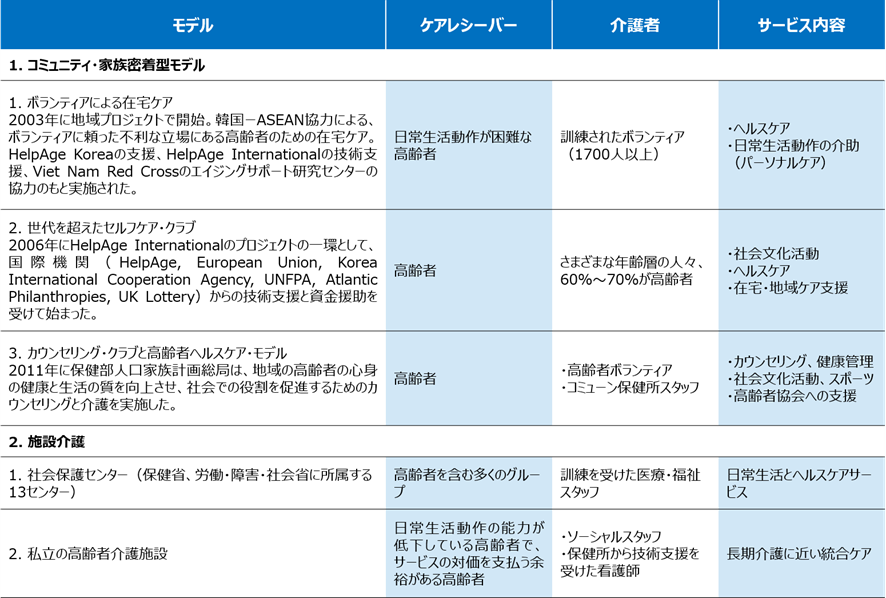
Specifically, the services needed by the elderly in Vietnam from time to time are as follows
- Income support: pays for daily living expenses from monthly allowances, pensions, relatives/friends, and savings.
- Medical care: medical and nursing care for the elderly for illnesses, accidents, and chronic diseases.
- Rehabilitation care: rehabilitation and independent living for the elderly.
- Health Care: When an elderly person’s functions deteriorate and they are no longer able to live independently and need assistance with bathing, dressing, eating, shopping, etc.
- Mental Health Services: when an elderly person is lonely, depressed, forgetful, or distracted.
- Behavioral care services: to assist seniors with abrupt behavior patterns.
- Assistance for seniors to participate in community activities: when seniors are lonely and isolated and have difficulty communicating and making friends.
- Housing services: maintenance, home repair or relocation for older adults with disabilities.

Examples of Major Care Service Companies in Vietnam
Previously, Nursing Homes and Elderly Care Centers in Vietnam did not have much presence and did not receive much attention or investment, and the quality of services was not stable. However, over time, Vietnam’s Nursing Homes and Elderly Care Centers have been improving.
This chapter will introduce companies that provide nursing care services in Hanoi and Ho Chi Minh City.
Care Service Company in Hanoi
First, let us introduce some of the companies in Hanoi.
Bach Nien Thien Duc Elderly Care Center

| type | private management |
| location | Hanoi, Vung Tau City |
| management | Bach Nien Thien Duc Co, Ltd. |
| establishment | 2009 |
| HP | https://duonglaothienduc.com/ |
Bach Nien Thien Duc Elderly Care Center is one of the oldest elderly care facilities in Vietnam. All of the center’s nursing staff are graduates of specialized medical colleges and are trained in caring for the elderly. After 21 years of operation, the center operates five facilities in Hanoi and Vung Tau.
On August 30, 2018, a ceremony was held at the official residence of the Japanese ambassador to Japan to convey the 2008 Foreign Minister’s Commendation to the Director, Nguyen Thua Ngoc City.
The Bach Nien Thien Duc Elderly Care Center provided free and dedicated care for 7.5 years, from June 2010 to January 2018, to a Japanese national who had difficulty walking on his own and needed assistance due to the aftereffects of a brain hemorrhage.
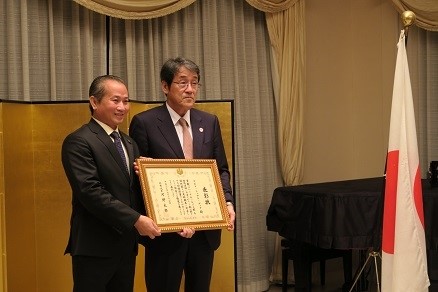
Dien Hong Nursing Home

| type | private management |
| location | Hanoi |
| management | Phuong Dong Pharmacy, Kim Investment & Construction Co. |
| establishment | 2014 |
| HP | duonglaodienhong.vn |
Dien Hong Nursing Home is a privately owned and operated facility located in the heart of Hanoi. The home was built with the aim of sharing family and caregiving responsibilities with the elderly and providing optimal care solutions for families so that they can sustain their lives and take care of their grandparents and parents. It is also dedicated to the development of highly specialized human resources.
Duyen Hong Nursing Home, established in September 2014, is now a reliable source of care for the elderly and families of those who have suffered accidents and disasters in Hanoi and Quang Binh Province and other areas.
Duyen Hong Nursing Home also has four major facilities in Hanoi and is the top nursing home in Vietnam in terms of beds.
Ho Chi Minh City Nursing Service Company
Here we introduce some of the care service companies in Ho Chi Minh City.
Binh My Nursing Home

| type | private management |
| location | Ho Chi Minh |
| management | An Binh My Investment Co. |
| establishment | 2012 |
| HP | https://duonglaothienduc.com/ |
Binh My Nursing Home is a reputable private nursing home located in Cu Chi District, Ho Chi Minh City. It is one of the largest in southern Vietnam. Skilled and experienced staff provide 24/7 care, regular thermal medical support from a family doctor, health promotion, and rehabilitation using the latest medical equipment.
Thi Nghe Elderly Care Center

| type | national |
| location | Ho Chi Minh |
| management | Ho Chi Minh City Department of Labor, Disability and Social Affairs |
| establishment | 1996 |
| HP | https://duonglaothinghe.business.site/ |
Thi Nghe Elderly Care Center was established in 1996 and is a national institution.
After more than 20 years of operation, the current Thi Nghe Elderly Care Center has a staff of 20 doctors, nurses, and assistants, and cares for approximately 80 elderly people. The facility is also invested by the government and has 15 individual houses built like villas.
Conclusion・Future Outlook
The market for long-term care services in Vietnam is shown to be very promising, with 20 million “potential customers” by 2035. On the other hand, a pressing issue is that the current supply of long-term care services in Vietnam is significantly insufficient. This includes not only increasing the number of nursing homes and other long-term care facilities, but also establishing a framework for long-term care care care by families and communities.
Therefore, there is ample room for Japanese companies to enter the Vietnamese nursing care market. In addition to the one-way supply of nursing care know-how, etc., there is also the possibility of exchanging and accepting nursing care personnel between Japan and Vietnam, which would be of great benefit to Japanese firms. In addition, Vietnam should focus on the utilization of silver human resources in the future, as Japan does.
Accurate information should be collected when entering the Vietnamese market. Advice should be obtained from experts in related fields.
【関連記事】ベトナムの介護と関連分野については、こちらの記事も合わせてご覧ください。
ベトナム市場調査レポート一覧はこちらからもご覧頂けます。

ベトナム市場の情報収集を支援します
ベトナム市場での情報収集にお困りの方は多くいらっしゃるのではないでしょうか。
VietBizは日本企業の海外事業・ベトナム事業担当者向けに市場調査、現地パートナー探索、ビジネスマッチング、販路開拓、M&A・合弁支援サービスを提供しています。
ベトナム特化の経営コンサルティング会社、ONE-VALUE株式会社はベトナム事業に関するご相談を随時無料でこちらから受け付けております。

